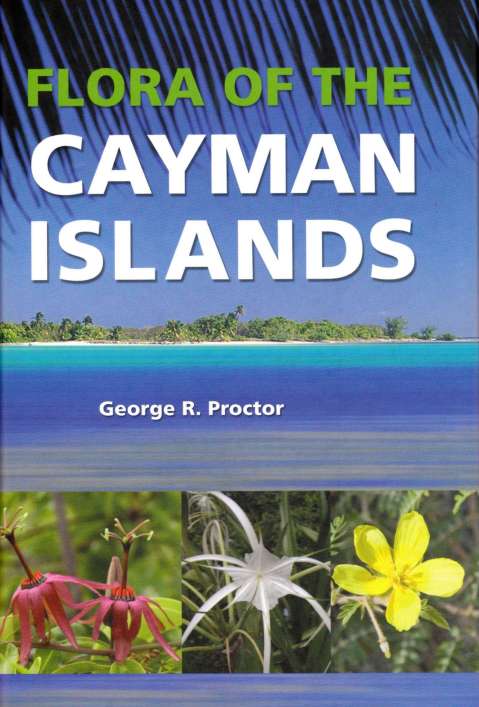1938 Oxford University Biological Expedition to the Cayman Islands

by P. Ann van B. Stafford, April 2017
Population of the Cayman Islands was 5,930 in 1931 and 6,690 in 1943.
The storm devastated the Cayman Islands, especially Cayman Brac (from Nov. 7-9), which was inundated by the storm surge, reported to be as high as 10 m (33 ft). The wind was estimated at 200mph. Some people took refuge in the caves. Many homes and buildings were washed out to sea, many people had to climb trees to escape the floodwaters. 110 people died on the islands; one of them was on Grand Cayman and the rest were on Cayman Brac. The ship Balboa also sank as a result of the storm.
1938
The 1938 Oxford University Biological Expedition to the Cayman Islands (April 16 to August 27) was the first natural history survey of all three islands, Grand Cayman, Little Cayman and Cayman Brac, and reports were written about the flora, fauna, geology and wetlands. The founding study of Cayman’s butterflies was done then by entomologists C. Bernard Lewis and Gerald H. Thompson, both Oxford students, (Carpenter and Lewis 1943) and gave a good indication of the number of species on each island at that time.
The expedition was in acceptance of a long-standing invitation by Cayman Islands Commissioner Allen Wolsey Cardinall (1934-1941) to make a biological survey of the islands. Lewis was a Rhodes scholar from the United States, who later became Director of the Institute of Jamaica in Kingston. The identification & documentation of specimens were delayed by of the outbreak of World War II in 1939.
The Butterflies (Lepidoptera: Rhopalocera) collected and observed were fully discussed and published in 1943 by Carpenter and Lewis. (G.D. Hale Carpenter, Hope Department of Entomology, University Museum, Oxford and C.B. Lewis, Museum of the Institute of Jamaica).
CONTENTS
People: Oxford
People: Cayman
Places: Grand Cayman, Cayman Brac and Little Cayman
Transportation: Fyffes Line, CIMBOCO, truck, motor boat, skiff, catboats, HMS Orion
Accommodation: Headquarters in George Town
Animals: Freshwater Turtles
Animals: Sea Turtles
Animals: Reptiles – Lizards and Iguanas
Animals: Reptiles – Geckos
Animals: Reptiles – Snakes
Animals: Insects – Dragonflies, Damselflies
Animals: Insects – Termites
Animals: Insects – Cicadas
Animals: Insects – True Bugs
Animals: Insects – Beetles
Animals: Insects – Bees, Ants, Wasps
Animals: Insects – Butterflies (Lepidoptera: Rhopalocera)
Animals: Insects – Moths (Lepidoptera)
Animals: Insects – Flies (Diptera) – Mosquitoes
Animals: Insects – other
Animals: Arachnids
Animals: Birds
Animals: Marine
Plants
Poem of farewell by Leila E. Ross
Return to the UK
Links
Selected References
PEOPLE
Oxford:
The party comprised:-
W. Gemmell Alexander (Brasenose College) – Leader and Organiser
C. Bernard Lewis (Wadham College) – Biologist (Rhodes Scholar from the United States) (lewisi)
Gerald H. Thompson (St. Edmund Hall) – Biologist (thompsoni)
W. Neil Paton (Magdalen College) – Marine Biologist
Wilfred Kings Lawrence Sheriff School, Rugby – Botanist (kingsii)
Cayman:
Allen Wolsey Cardinall – Commissioner of the Cayman Islands, from 1934 to 1941
Ernest Panton – Assistant Commissioner
Joseph Rodriguez (Roddie) Watler – Police Inspector, truck owner
Bentley (Benny) Ross – boat owner – the ‘BRAVO’
Urban Myles – cook
Norris Jackson – assistant
Pershing Merren – assistant
Sam Ebanks – assistant
John Howard – assistant
Ira Thompson – Commissioner’s chauffeur
W. Gemmell ALEXANDER (1918-2014)
(Brasenose College) – Leader and Organiser
The son of a solicitor, William Gemmell Alexander was born at Hooton, Cheshire, on August 19, 1918. After education at Sedbergh School he signed on with a North Sea trawler at a shilling a day before going up to Brasenose College, Oxford, to read Law.
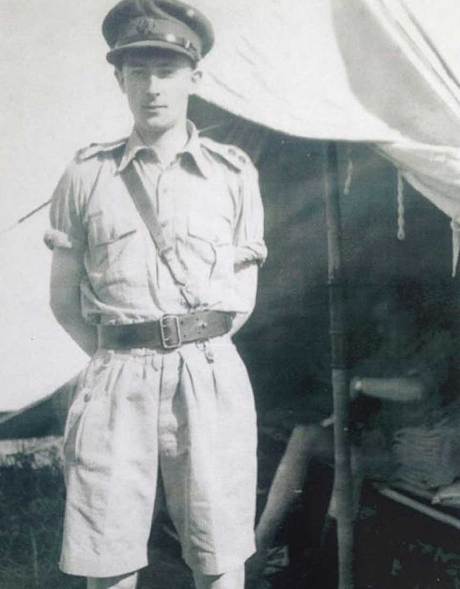
 Gemmell Alexander – 1938 Oxford Expedition Leader and Organiser, had his 20th. birthday in Kingston, Jamaica, on his return from Cayman. Caymanian Compass, March 15, 2004.
Gemmell Alexander – 1938 Oxford Expedition Leader and Organiser, had his 20th. birthday in Kingston, Jamaica, on his return from Cayman. Caymanian Compass, March 15, 2004.
National Trust for the Cayman Islands – Insectarium
Gemmell Alexander 1918-2014 Obituary
In 1938 he was a leader of the Oxford expedition to identify the mosquitoes that were preventing the development of a tourist industry in the Cayman Islands.
Oxford Today – Oxonian Lives Sept. 2014
Charles Bernard LEWIS (1913-1992)
born in Massachussetts, USA, a man of wide interests: Biology, Geology, History, Archeology and Art.
Brown University, Rhode Island, and John Hopkins University, USA; Rhodes Scholar Oxford University (Wadham College), UK
1938 Oxford University Biological Expedition to the Cayman Islands, where he met his future wife, Lucille Bodden, daughter of Cuthbert Bodden. Lewis was unable to complete his education at Oxford because of the outbreak of the Second World War (1939). After returning from Cayman to England, he and most other American civilians there, were asked to leave the UK and return to the United States.
1939 September – C. B. Lewis set up the Natural History Museum in JAMAICA. He was the curator.
1940 October – in Jamaica he married Lucille Bodden of Grand Cayman. They had four children – Mary, Bill, David and Richard.
1940 Herpetology of the Cayman Islands by Chapman Grant and Charles Bernard Lewis, Institute of Jamaica, Reptiles, 65 pages The Herpetology of the Cayman Islands
The Discovery of the Blue Iguana
1950 Director of the Institute of Jamaica

Charles Bernard Lewis by Margaret Hodges, p.6
Gerald H. THOMPSON (1917-2002) (St. Edmund Hall) – Biologist (thompsoni)
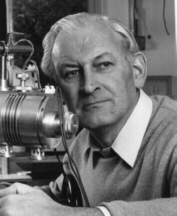
Gerald Harvey Thompson – biograpghy
Gerald Thompson – Pioneer of filming plants and small animals
1936-1939 Gerald read Zoology at St Edmund Hall, Oxford University. He had been awarded a County Exhibition. Secretaryship of The Oxford University Entomological Society 1938.
1938 Invited to be assistant entomologist on the Oxford University Exploration Club six month expedition to the three Cayman Islands in the West Indies. The purpose of the trip was to make a biological survey of the islands.
W. Neil PATON (1914-1942) (Magdalen College) – Marine Biologist (reported missing off Malta in June 1942 and was presumed killed, World War II)
Neil worked from his base, a small schooner ‘Meritwell’, in North Sound, Grand Cayman. Each specialist told Gemmell Alexander what they wanted. Gemmell helped them, especially the marine biologist, who was developing a technique for preserving live corals. He had to get the corals out of the sea, nurse them back to the ship or land, then had to keep them at the right light and right temperature and no disturbance, so that their gelatinous fronds were floating about. He had to drop a little formaldehyde into the water with a pipette, so they actually died expanded.
(Cayman Islands National Archive)
Wilfred KINGS (1889-1980) Lawrence Sheriff School, Rugby – Botanist (kingsii)
Until the age of twelve, Gerald Thompson was educated at Hyndland Secondary School, Glasgow, after which he attended Lawrence Sheriff School, Rugby from 1929-1936. He was Head Boy in 1936.
He knew from an early age that he wanted to be a zoologist and two men at Lawrence Sheriff School made this dream a reality. On entering the 6th Form Gerald asked to take Zoology as his main subject for Higher National certificate (‘A’ level equivalent). This was in 1933 and the subject was not included in the School teaching syllabus. The Headmaster, Cordy Wheeler, pointed out that there was neither teacher nor facilities for practical work at Lawrence Sheriff but that he would see what could be done. A few days later he told Gerald that the geography master, Wilfred Kings – who had taken a Degree in Biology eighteen years earlier – had agreed to teach him, largely in his spare time. As a sixteen year old Gerald had no conception of what this entailed; little did he know that for two years Wilfred researched and wrote to keep one lecture ahead of him. In later years he came to appreciate the disruption to Wilfred’s home life for even Sunday mornings were spent doing practicals in the biology laboratory of Rugby School which kindly lent their facilities.
Wilfred Kings was given leave of absence from Lawrence Sheriff School in 1938 when, aged 20, Gerald was invited to join The Oxford University expedition to the Cayman Islands; Wilfred was included in the expedition as Botanist on Gerald’s recommendation, and hence their partnership was renewed. The Pond – a book by Gerald and Oxford Scientific Films was dedicated by Gerald to the memory of Wilfred Kings 1889-1980 – ‘a great teacher and a wonderful friend’.

Oxford University Biological Expedition to the Cayman Islands 1938 – homemade equipment, the still – for recovering waste alcohol. (C. B. Lewis photo 1938). Alcohol was needed for the preservation of specimens.
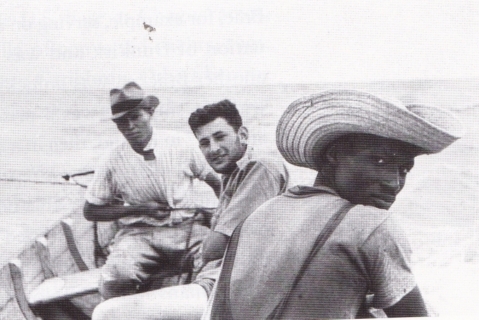
Sam Ebanks, Gerald Thompson and John Howard – off to work – Oxford University Biological Expedition to the Cayman Islands (C. B. Lewis photo 1938)
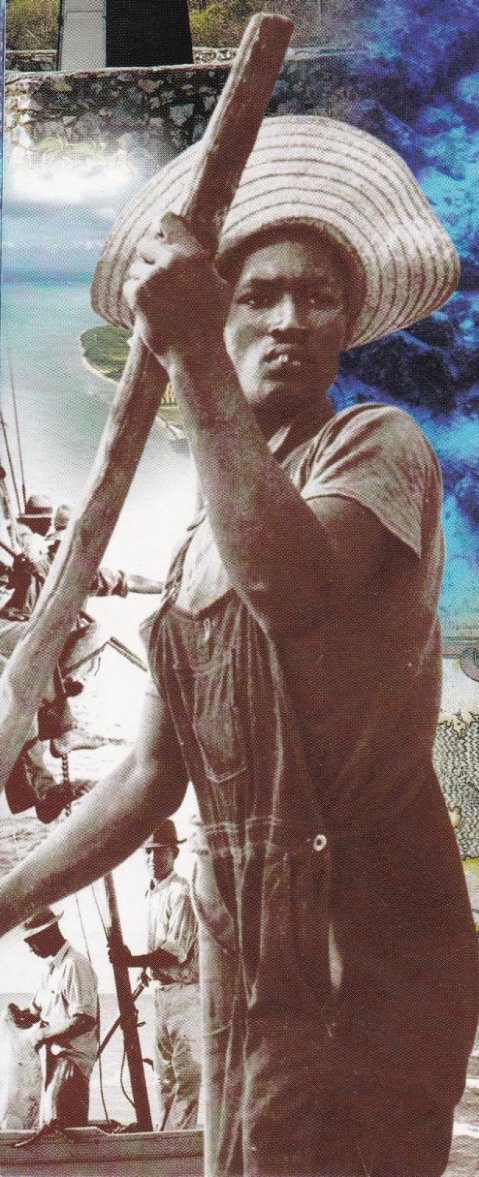
John Howard, (C. B. Lewis photo 1938)
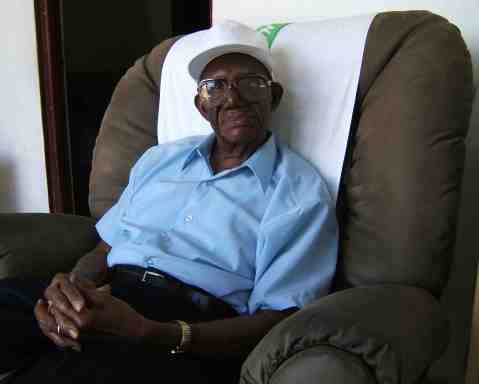
Urban Myles, 97 years old. He was the cook on the 1938 Oxford University Biological Expedition to the Cayman Islands.
They camped on the little schooner ‘Meritwell’ in North Sound for one week
and used a motor boat and canoe for their biological observations and collections.
Photo: Ann Stafford, Mar. 3, 2007.
PLACES
Liverpool, UK; Kingston, Jamaica; Grand Cayman (population:4,500); Cayman Brac (population: 1,500); Little Cayman (population: 64).

Caribbean map
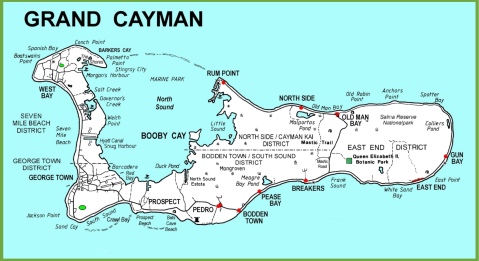
Grand Cayman map
Grand Cayman, Wilfred Kings, botanist: May 13 – 17 and June 11 – August 10.
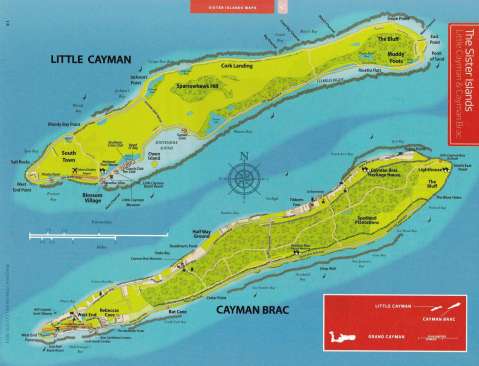
Little Cayman and Cayman Brac – the Sister Islands (Acorn Publishing Co Ltd 2013)
Cayman Brac, Wilfred Kings, botanist: May 18 – May 28.
Little Cayman, Wilfred Kings, botanist: May 28 – June 11
 Oxford from Boars Hill, Oxfordshire, UK
Oxford from Boars Hill, Oxfordshire, UK
TRANSPORTATION
Fyffes Line fleet were passenger-carrying banana boats , owned and operated by UK banana importer, Elders and Fyffes Limited.
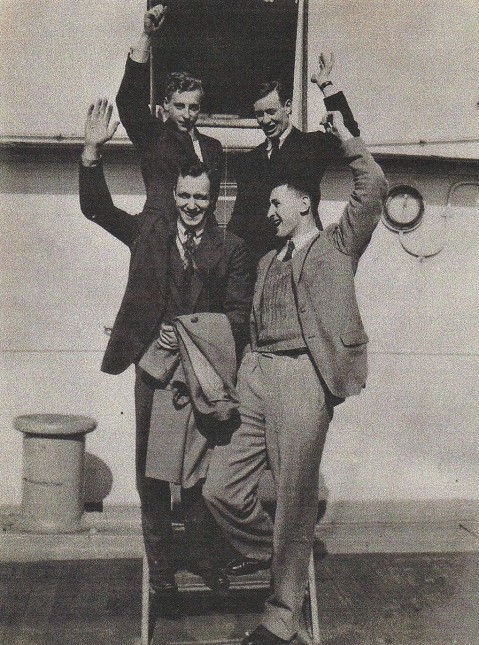
Bernard, Gemmell, Neil and Gerald sailed from Liverpool, UK on the Fyffes Line ship SAMALA on March 22, (14 days voyage) to Kingston, Jamaica, then on the CIMBOCO (motor boat) from Kingston to Grand Cayman. Wilfred Kings left the UK in April and joined them in Grand Cayman.
Richard Arlington Bush, Caymanian seaman onboard the SAMALA, was brother-in-law of Cayman Islands Assistant Commissioner, Ernest Panton. (Ref. Gemmell Alexander’s red diary 1938, in the Cayman Islands National Archive.)
Transportation in the Cayman Islands: truck, motor boat, catboats.
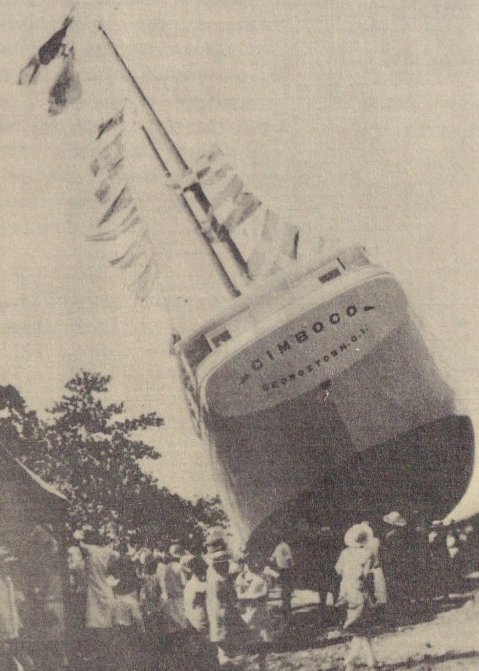
CIMBOCO, Cayman Islands Motor Boat Company, was the first locally built, motorized sailing ship in Cayman. CIMBOCO was Cayman’s connection to the world: regular travel, shipping, parcel post, providing a reliable supply of staple & exotic foods, such as flour, sugar, fruit & even ice! “Her launching in May 1927 was a great day in the history of the Cayman Islands,” said Miss Annie Huldah Bodden, secretary until 1947.
Launching of the CIMBOCO, May 1927, photo: N.L Booker, father of Aarona Booker Kohlman, who is the author of ‘UNDER TIN ROOFS Cayman in the 1920’s’ (1993).

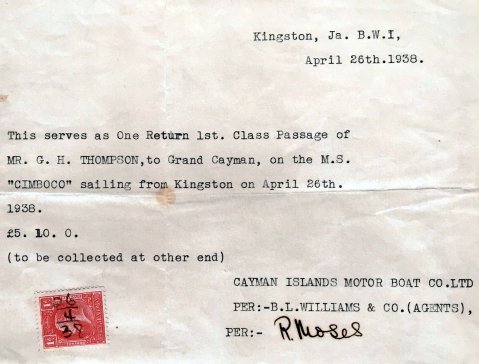
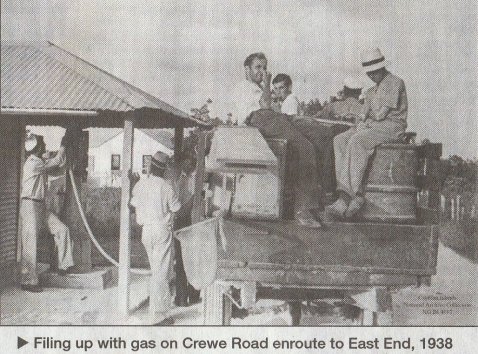
1929 Ford truck was used to get the team and their wooden cases of collection equipment around Grand Cayman.
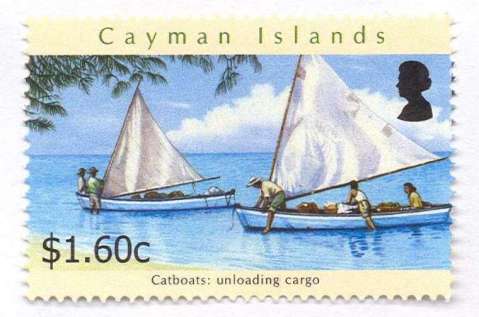
Catboats: unloading cargo stamp $1.60, (release date Aug. 31, 2011).
CIMBOCO and HMS Orion from Grand Cayman to Kingston, Jamaica.
ACCOMMODATION
Expedition Headquarters in George Town – Althea’s cottage
Rum Point – tents
North Sound – Schooner MERITWELL
Cayman Brac – Aston Rutty’s house
Little Cayman – Capt. Sam Bodden’s house
South Sound – Czar Hurlston’s house
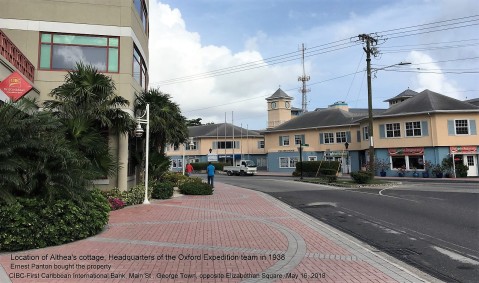 Location of Althea’s cottage, George Town, Headquarters of the Oxford University Expedition Team in 1938. Ernest Panton bought the property (between 1938 and 1943). CIBC-First Caribbean International Bank, Main St occupies the location now, opposite Elizabethan Square. (Photo: May 16, 2018)
Location of Althea’s cottage, George Town, Headquarters of the Oxford University Expedition Team in 1938. Ernest Panton bought the property (between 1938 and 1943). CIBC-First Caribbean International Bank, Main St occupies the location now, opposite Elizabethan Square. (Photo: May 16, 2018)
Who was Althea? Sisters Althea and Olive Jennett married brothers Hugh and Cuthbert Bodden. Althea and Hugh (a sea captain) moved to Jamaica. Ernest Panton bought the property (between 1938 and 1943). Cuthbert and Olive’s daughter, Lucille Bodden, married Bernard Lewis in Jamaica on October 30, 1940. Lewis had been appointed curator of the Natural History Museum at the Institute of Jamaica September 1, 1939, the day Hitler invaded Poland.
 ‘Oxford House’ (photo: Ann Stafford, Nov.30, 2007). The team stayed in Czar Hurlston’s house on South Sound. It was subsequently moved to South Church St, its current location. The front porch was added.
‘Oxford House’ (photo: Ann Stafford, Nov.30, 2007). The team stayed in Czar Hurlston’s house on South Sound. It was subsequently moved to South Church St, its current location. The front porch was added.
ANIMALS
REPTILES: Freshwater Turtles
Hickatee, Taco River Slider – Trachemys decussata angusta (introduced, weel-established)
REPTILES: Sea Turtles
Loggerhead turtle – Caretta caretta
Green Turtle – Chelonia mydas
Hawksbill Turtle – Eretmochelys imbricata
REPTILES: Lizards and Iguanas
Lizards:
Eastern Grand Cayman Blue-throated Anole – Anolis conspersus lewisi (endemic)
Reptile Database – Anolis conspersus
Anole Adventures in the Cayman Islands
Iguanas:
The endemic Blue Iguana – Cyclura lewisi, Grand Cayman’s largest native land animal, is named after Bernard Lewis.
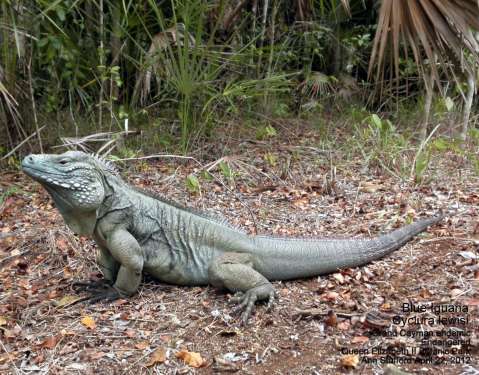 Blue Iguana – Cyclura lewisi, Endangered Grand Cayman endemic, named after biologist C. Bernard Lewis, Rhodes Scholar, who took a male and female to the British Museum of Natural History, collected during the 1938 Oxford University Biological Expedition to the Cayman Islands. Photo: Ann Stafford, on the Woodland Trail, Queen Elizabeth II Botanic Park, Grand Cayman, Apr. 22, 2012.
Blue Iguana – Cyclura lewisi, Endangered Grand Cayman endemic, named after biologist C. Bernard Lewis, Rhodes Scholar, who took a male and female to the British Museum of Natural History, collected during the 1938 Oxford University Biological Expedition to the Cayman Islands. Photo: Ann Stafford, on the Woodland Trail, Queen Elizabeth II Botanic Park, Grand Cayman, Apr. 22, 2012.
Cyclura lewisi Grant, 1940 Synonyms: Cyclura macleayi ssp. lewisi Grant 1940 Cyclura nubila ssp. lewisi Grant, 1940
IUCN Red List – Blue Iguana (International Union for Conservation of Nature)
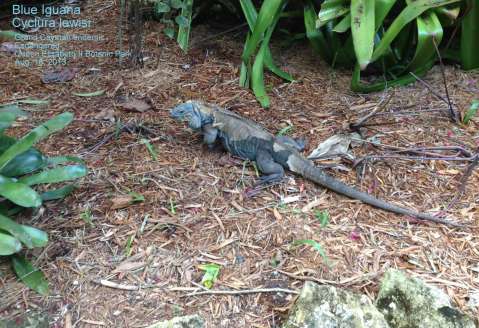 Blue Iguana – Cyclura lewisi. Photo: Ann Stafford, on the Woodland Trail, Queen Elizabeth II Botanic Park, Grand Cayman, Aug.18, 2013.
Blue Iguana – Cyclura lewisi. Photo: Ann Stafford, on the Woodland Trail, Queen Elizabeth II Botanic Park, Grand Cayman, Aug.18, 2013.
The Herpetology of the Cayman Islands
The Herpetology of the Cayman Islands (including the results of the Oxford University Cayman Islands Biological Expedition, 1938) with an appendix on the Cayman Islands and marine turtle, by Chapman Grant and C Bernard Lewis. Publisher: Institute of Jamaica, 1940.
Chapman GRANT (1887-1983) was an American herpetologist, historian and publisher. He was the last living grandson of United States, President Ulysses S. Grant.
 Grand Cayman Blue Iguana – Cyclura lewisi. Photo: Ann Stafford, Queen Elizabeth II Botanic Park, Grand Cayman, March 3, 2011.
Grand Cayman Blue Iguana – Cyclura lewisi. Photo: Ann Stafford, Queen Elizabeth II Botanic Park, Grand Cayman, March 3, 2011.
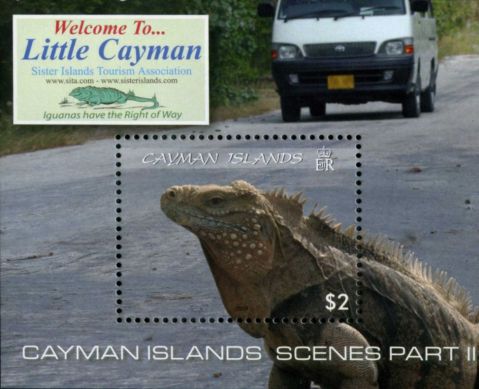 Sister Islands Rock Iguana (Lesser Cayman Islands Rock Iguana) – Cyclura nubila caymanensis, subspecies endemic to Little Cayman and Cayman Brac.
Sister Islands Rock Iguana (Lesser Cayman Islands Rock Iguana) – Cyclura nubila caymanensis, subspecies endemic to Little Cayman and Cayman Brac.
REPTILES: Geckos
Ground Gecko, Cayman Least Gecko – Sphaerodactylus argivus
This Antillean species is endemic to the Cayman Islands (Henderson and Powell 2009).
Ground Gecko, Wood Lizard – Spherodactylus argivus lewisi, Grand Cayman endemic subspecies. It probably occurs island-wide, including the satellite islands. It has been found under rocks at the bottom of sink holes, in the mouths of caves on a limestone ridge (south of Old Man Bay), and in bromeliads (Seidel and Franz 1994) .
On Little Cayman, the subspecies bartschi probably occurs island-wide, but most known specimens were collected near the beach at South Town and at Tarpon Lake (Seidel and Franz 1994); it also occurs in Owen Island.
Cayman Brac, the subspecies argivus is found island-wide (Schwartz and Henderson 1991).
REPTILES: Snakes
Water Snake – Tretanorhinus variabilis lewisi, Grand Cayman endemic subspecies
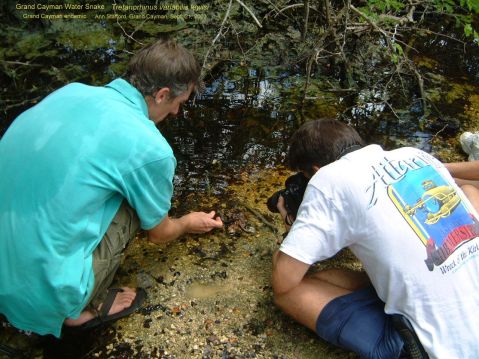
Grand Cayman Water Snake – Tretanorhinus variabilis lewisi, found by Fred Burton and photographed by Courtney Platt. Photo: Ann Stafford, Queen Elizabeth II Botanic Park, Sept. 21, 2003.
Grand Cayman Water Snake – Tretanorhinus variabilis lewisi, found by Fred Burton and photographed by Courtney Platt. Photo: Ann Stafford, Queen Elizabeth II Botanic Park, Sept. 21, 2003.

Grand Cayman Water Snake – Tretanorhinus variabilis lewisi, found by Fred Burton and photographed by Lois Blumenthal. Photo: Ann Stafford, Queen Elizabeth II Botanic Park, Sept. 21, 2003.
INSECTS
The Insect Fauna of Little Cayman by R.R. Askew 1980
Atoll Research Bulletin No. 241: 97-114 1980
The 1938 Oxford University Biological Expedition spent thirteen days on Little Cayman and reports on the resulting collection deal with Odonata (Fraser, 1943), water-bugs (Hungerford, 1940), Neuroptera (Banks, 1941), cicadas, (Davis, 1939), Carabidae (Darlington, 1947), Cerambycidae (Fisher, 1941, 1948), butterflies (Carpenter & Lewis, 1943) and Sphingidae (Jordan, 1940).
Classification of Insect Orders
INSECTS: DRAGONFLIES, DAMSELFLIES (Order: Odonata)
called Needlecases in Cayman
Suborder: Zygoptera DAMSELFLIES
Lestes spumarius – Antillean Spreadwing
GC, CB. The only Damselfly found in 1938, but subsequently only a single specimen has been recorded.
Suborder: Anisoptera DRAGONFLIES
Anax amazili – Amazon Darner
Orthemis ferruginea – Roseate Skimmer
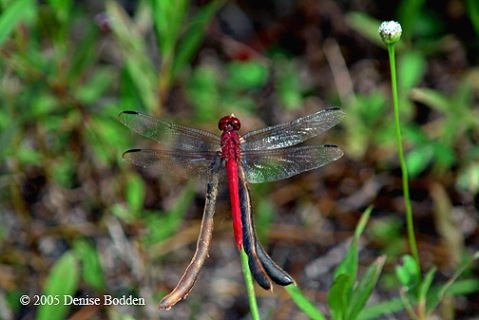
Roseate Skimmer – Orthemis ferruginea. Photo: Denise Bodden, Frank Sound, Grand Cayman, August 29, 2005
Pantala flavescens – Wandering Glider
Pantala hymenaea – Spot-winged Glider
Brachymesia furcata – Red-tailed Pennant
Micrathyria didyma – Three-striped Dasher
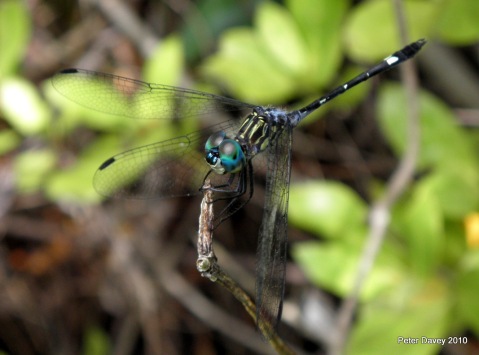
Three-striped Dasher – Micrathyria didyma, conspicuous white spot on the seventh segment of the slender abdomen. Photo: Peter Davey, Grand Cayman, Nov. 22, 2010.
Tramea calverti – Striped Saddlebags
Erythemis vesiculosa (= Lepthemis vesiculosa) – Great Pondhawk
 Great Pondhawk – Erythemis vesiculosa. Photo: Royal Tyler, Grand Cayman, July 2, 2015
Great Pondhawk – Erythemis vesiculosa. Photo: Royal Tyler, Grand Cayman, July 2, 2015
Erythemis plebeja – Pin-tailed Pondhawk
Erythrodiplax umbrata – Band-winged Dragonlet
Erythrodiplax berenice naeva (= Erythrodiplax naeva) – Seaside Dragonlet
Erythrodiplax connata
References:
The Cayman Islands Natural History and Biogeography
M.A. Brunt & J.E. Davies / Editors, 1994
Chapter 17 Insects of the Cayman Islands by R. R. Askew
ODONATA pp. 340-344.
Integrated Taxonomic Information System https://www.itis.gov/
INSECTS: TRUE BUGS (Order: Hemiptera, Sub-order: Heteroptera)
Family: Lygaeidae – Seed Bugs, most often on vegetation, a total of 17 species were found (Scudder 1958), 13 in Grand Cayman, 3 in Little Cayman and 8 in Cayman Brac. Four of these were described as new by Scudder:
Ochrostethus nigriceps sp.n;
Ozophora pallidifemur sp.n;
Ozophora minuscula sp.n; Grand Cayman
Ozophora fuscifemur sp.n; Cayman Brac
Aquatic Heteroptera were described by Hungerford (1940) – 11 species from Grand Cayman
Family: Hydrometridae – Water Measurers – Hydrometra martini
Family: Gerridae – Water Striders, usually found running around on the surface of the water – Limnogonus guerini
Family: Veliidae – Ripple Bugs – Microvelia pulchella and Rhagovelia tenuipes
Family: Belostomatidae – Giant Waterbugs, 40mm or more in length, are often attracted to lights – Lethocerus collosicus and Lethocerus delpontei
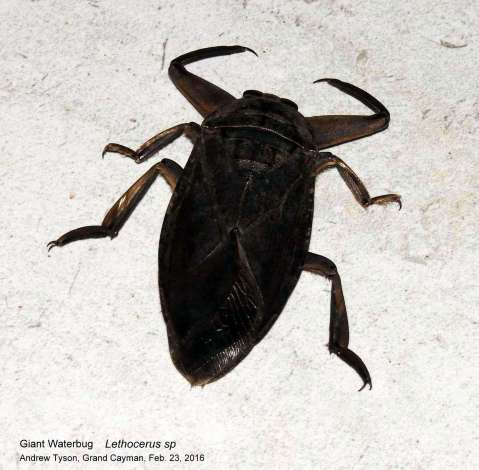
Giant Waterbug – Lethocerus sp. Photo: Andrew Tyson, Grand Cayman, Feb. 23, 2016.
Family: Corixidae – Water Boatmen, they swim rapidly and somewhat erratically – Trichocorixa verticalis (also in Little Cayman)
Family: Notonectidae – Backswimmers, so named because they swim upside down, resemble Water Boatmen – Notonecta indica, Buenoa antigone (also in Cayman Brac), B. pallens and B. elegans. Buenoa antigone was ‘swarming in thousands’ in Earthquake Hole (Stake Bay), Cayman Brac in 1938. Earthquake Hole is on the coast by Stake Bay Point, by Suncave Close, across Dennis Foster Road from Half Way Ground Cave / Skull Cave.
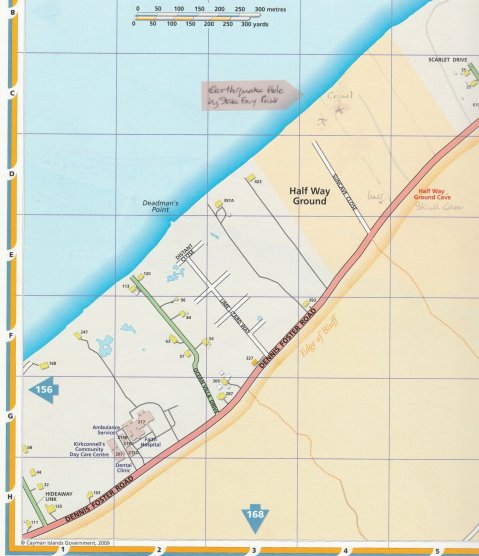
INSECTS: CICADAS (Order: Hemiptera – True Bugs, Sub-order: Auchhenorrhyncha (Cicadas, Leafhoppers)
Family: Cicadidae
Diceroprocta caymanensis Davis, 1939
Diceroprocta cleavesi Davis, 1930
Diceroprocta ovata Davis, 1939
Each island has its own endemic Cicada species –
Grand Cayman Cicada – Diceroprocta cleavesi
Little Cayman Cicada – Diceroprocta caymanensis
Cayman Brac Cicada – Diceroprocta ovata
The species are morphologically very similar, differing principally in their colouration, and they are allied to D. biconia from Cuba.
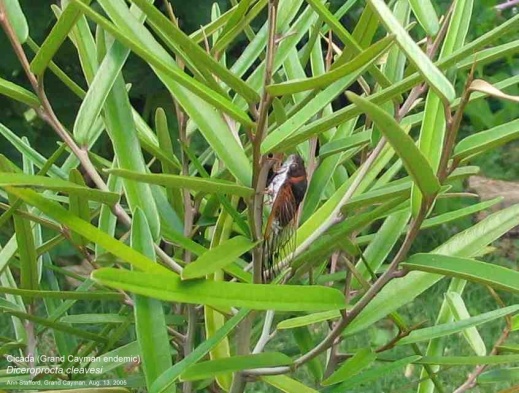
Grand Cayman Cicada – Diceroprocta cleavesi
Photo: Ann Stafford, Grand Cayman, Aug. 13, 2005
Cicadas are locally called ‘crickets’ . The male Cicadas’ ‘song’ is a high-pitched buzzing sound. Female Cicadas lay their eggs in the bark of a twig. When the eggs hatch, the nymphs drop to the ground. They burrow with their front legs, which are enlarged for tunneling, and they live underground, feeding on roots. When they are ready for their fifth and final molt, they dig their way out to the surface and climb a short distance on to a plant to which they anchors themselves. The winged adults emerge in July and August, leaving the empty nymph case attached to the plant.
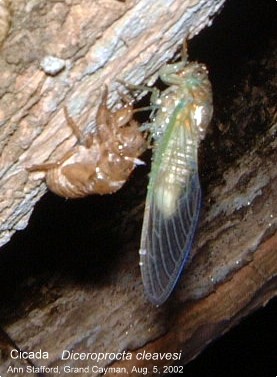
Adult Cicada, just emerged from its nymph exoskeleton. Photo: Ann Stafford, Grand Cayman, Aug. 5, 2002.
Cicadas collected in the Cayman Islands by the Oxford University Biological Expedition of 1938
Davis, William T. 1939 Journal of the New York Entomological Society, vol. 47, no. 3, pages 207-213
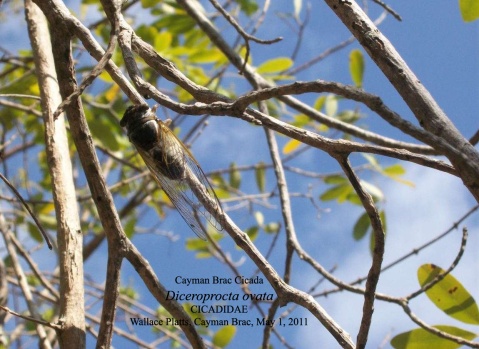
Cayman Brac Cicada – Diceroprocta ovata
Photo: Wallace Platts, Cayman Brac, May 1, 2011.
INSECTS: BEETLES: (Order: Coleoptera)
Visual Guide to Beetle Families
Family: Carabidae – Ground Beetles
Family: Staphylinidae – Rove Beetles
Family: Scarabaeidae – Chafers and Dung Beetles
Family: Cerambycidae – Long-horned Beetles or Timber Beetles
Cerambycidae Family, SubFamily and Tribe List
Styloleptus lewisi (Fisher) 1948, (synonym: Leptostylus lewisi)

Long Horned Beetle – Elaphidion lewisi Fisher 1941. British Museum Natural History, London, UK. Photo: John Chemsak. Stake Bay, Cayman Brac
Elaphidion thompsoni Fisher 1941
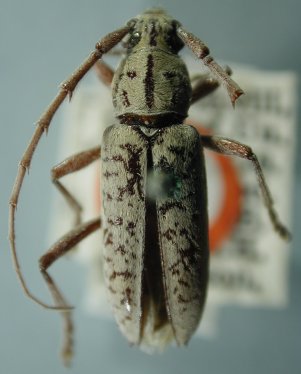
Long Horned Beetle – Elaphidon thompsoni Fisher 1941. British Museum Natural History, London, UK. Photo: Larry G. Bezark. Stake Bay, Cayman Brac
Anelaphus fasciatum (Fisher 1932) (synonym: Elaphidion truncatipenne)
Eburia caymanensis Fisher 1941
Eburia concisispinis Fisher 1941
Eburia lewisi Fisher 1948
Derancistrus (Elateropsis) nigripes (Fisher) 1941
Derancistrus (Elateropsis) nigricornis (Fisher) 1941
Derancistrus (Elateropsis) caymanensis (Fisher) 1941
INSECTS: BEES, ANTS, WASPS: (Order: Hymenoptera)

Caribbean Cicada Killer Wasp, Mangrove Giant Wasp – Sphecius hogardii
INSECTS: BUTTERFLIES: (Order: Lepidoptera: Rhopalocera)
More photos: CaymANNature Butterflies, Moths and their Plants
Cayman Brown Leaf Butterfly – Memphis verticordia danielana – Cayman Islands endemic subspecies
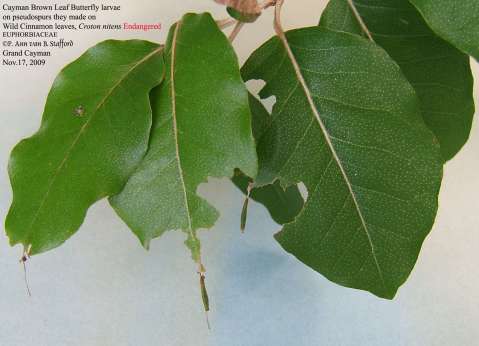 Cayman Brown Leaf Butterfly – Memphis verticordia danielana larvae on their pseudospurs they made on their larval food plant Wild Cinnamon – Croton nitens, Ann Stafford, Grand Cayman, Nov. 17, 2009.
Cayman Brown Leaf Butterfly – Memphis verticordia danielana larvae on their pseudospurs they made on their larval food plant Wild Cinnamon – Croton nitens, Ann Stafford, Grand Cayman, Nov. 17, 2009.
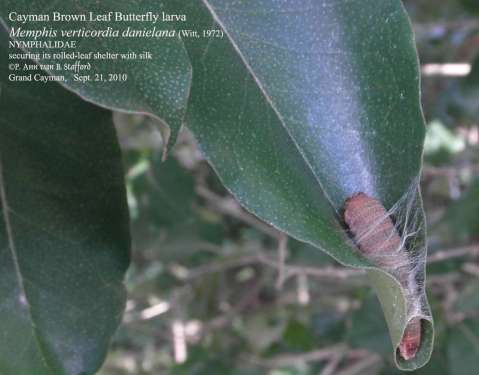
Cayman Brown Leaf Butterfly – Memphis verticordia danielana larva securing its rolled-leaf shelter with silk, on larval food plant Wild Cinnamon – Croton nitens, Ann Stafford, Grand Cayman,Sept. 21, 2010.
Memphis verticordia danielana life cycle
The endemic Pygmy Blue Butterfly – Brephidium exilis thompsoni Carpenter & Lewis 1943 is named after Gerald Thompson. He discovered it on June 23, 1938 in English Sound (named after T.M. Savage English), a lagoon off North Sound.
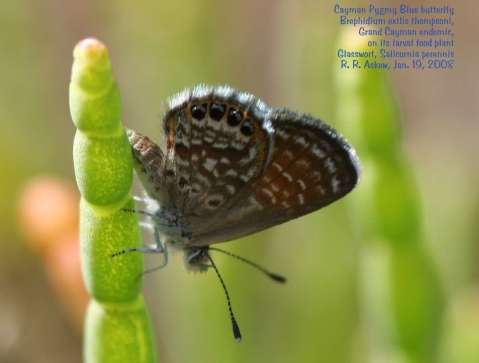
Cayman Pygmy Blue butterfly – Brephidium exilis thompsoni, Grand Cayman endemic subspecies named after Gerald Harvey Thompson, 1938 Oxford University biology student.
Photo: R. R. Askew, Jan. 19, 2008
ANNALS OF THE CARNEGIE MUSEUM Vol.XXIX p.392-394
Carpenter & Lewis 1943:
This tiny butterfly is indeed limited in its distribution for it was not found outside of an area of about fifty square yards, on the edge of a secluded lagoon, known as English Sound, lying to the east of and off of the Great Sound. The vegetation of this area is low, but not unusual, and is typical of such situations which are numerous on the island. No early stages were found.
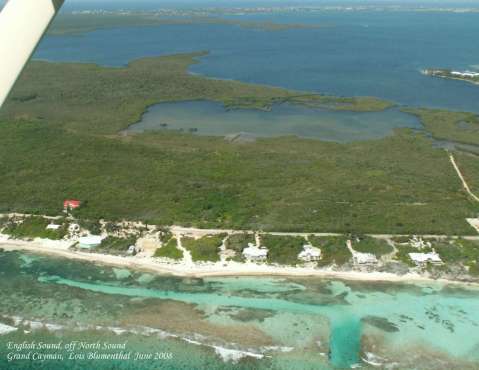
English Sound is a very shallow lagoon off North Sound, Grand Cayman, where Grand Cayman’s Pygmy Blue butterfly – Brephidium exilis thompsonii was discovered by Bernard Lewis and Gerald Thompson in 1938. English Sound is not named on maps, but was the locality of property of naturalist T. M. Savage English, who resided in Grand Cayman from late 1910 to 1914.
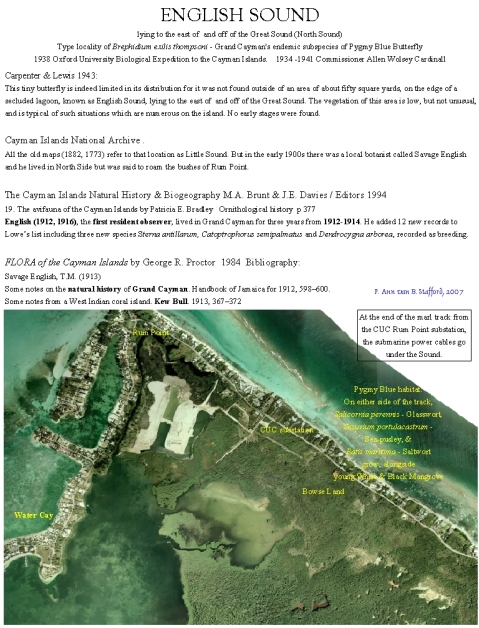
Naturalist Thomas Mylius Savage English lived in Grand Cayman between late 1910 and 1914. He owned property in the Cayman Kai area. This shallow lagoon, English Sound, is named after him, but it is not named on maps. The location of his dock can be seen in the centre of this photo.
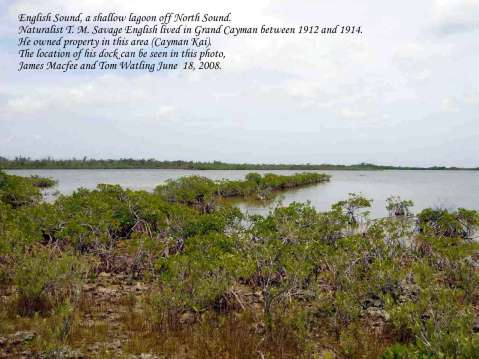
Photo: Kayaker James Macfee June 18, 2008
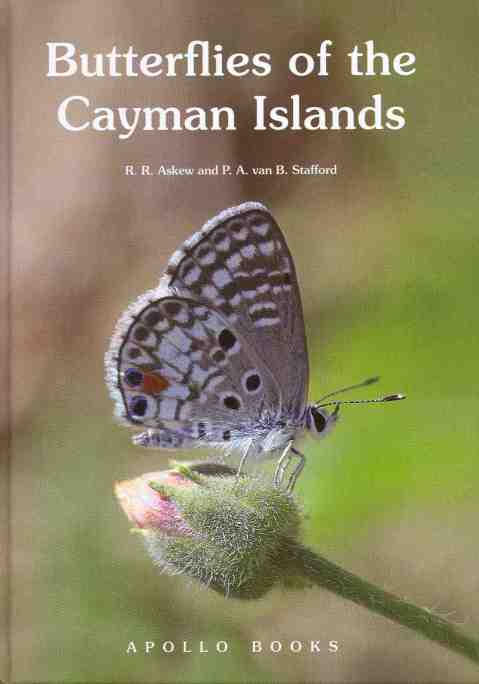
Butterflies of the Cayman Islands 2008 by R.R. Askew and P.A. van B. Stafford 2008
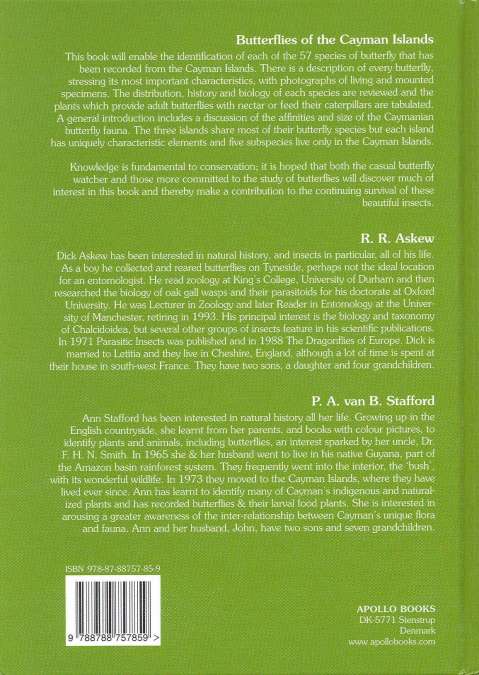
This book includes records from the
1938 Oxford University Expedition to the Cayman Islands and
1975 Joint Royal Society – Cayman Islands Government Expedition to Little Cayman
INSECTS: MOTHS (Order: Lepidoptera)
Cayman Islands Moth Stamps, issued Oct. 12, 2017.
Stamps designed by M. Letitia Askew, information leaflet by R.R. Askew.
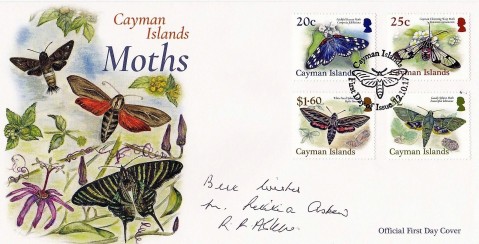
Family: Sphingidae – Sphinx or Hawk Moths
Heinrich Ernst KARL JORDAN (1861-1959)
1940 Results of the Oxford University Biological Expedition to the Cayman Islands 1938. Sphingidae (Lep.) Ent. mon. Mag.76, 275-277
Entomologist’s Monthly Mag. Vol. 76 pp 275-277
Sphinginae
Agrius cingulata – Pink-spotted Hawk Moth, Sweet-potato Hornworm

Pink-spotted Hawk Moth, Sweet-potato Hornworm – Agrius cingulata, live specimen caught and released by 12 year old Jonathan Bodden, Grand Cayman, Nov.18, 2017, (some scales missing from the head).
 Pink-spotted Hawk Moth, Sweet-potato Hornworm – Agrius cingulata. Lois Blumenthal, The Bat Lady, had responded to a bat call, but these were not bats. Photo: Sonny Rivers, Grand Cayman, June 2005.
Pink-spotted Hawk Moth, Sweet-potato Hornworm – Agrius cingulata. Lois Blumenthal, The Bat Lady, had responded to a bat call, but these were not bats. Photo: Sonny Rivers, Grand Cayman, June 2005.
Cocytius antaeus – Giant Sphinx Moth
 Giant Sphinx Moth – Cocytius antaeus. Caterpillar fed on Soursop – Annona muricata, in the garden of Mars van Liefde. Photo: Ann Stafford, Grand Cayman, Dec.2, 2003.
Giant Sphinx Moth – Cocytius antaeus. Caterpillar fed on Soursop – Annona muricata, in the garden of Mars van Liefde. Photo: Ann Stafford, Grand Cayman, Dec.2, 2003.
 Giant Sphinx Moth – Cocytius antaeus caterpillar feeding on Sweetsop, Sugar Apple – Annona squamosa, found by Elisa Piper at Little Trotters Farm and Nursery School. Photo: Ann Stafford, Grand Cayman, June 20, 2006.
Giant Sphinx Moth – Cocytius antaeus caterpillar feeding on Sweetsop, Sugar Apple – Annona squamosa, found by Elisa Piper at Little Trotters Farm and Nursery School. Photo: Ann Stafford, Grand Cayman, June 20, 2006.
Manduca sexta – Carolina Sphinx Moth, Tobacco Hornworm
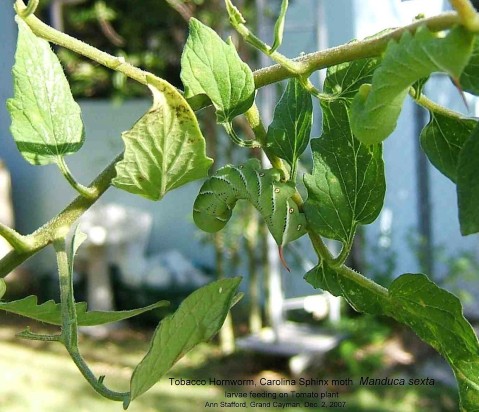 Tobacco Hornworm, Carolina Sphinx Moth – Manduca sexta, caterpillars feeding on Tomato plant. Photo: Ann Stafford, Grand Cayman, Dec. 2, 2007.
Tobacco Hornworm, Carolina Sphinx Moth – Manduca sexta, caterpillars feeding on Tomato plant. Photo: Ann Stafford, Grand Cayman, Dec. 2, 2007.
Manduca rustica – Rustic Sphinx Moth
Manduca brontes – Brontes Sphinx Moth
Protambulyx strigililis – Streaked Sphinx Moth
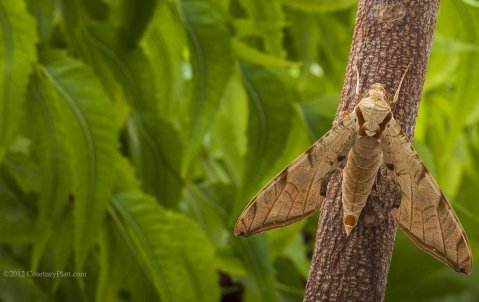 Streaked Sphinx Moth – Protambulyx strigililis. Photo: Courtney Platt, Grand Cayman, 2012.
Streaked Sphinx Moth – Protambulyx strigililis. Photo: Courtney Platt, Grand Cayman, 2012.
Macroglossinae
Pseudosphinx tetrio – Giant Grey/Tetrio Sphinx Moth
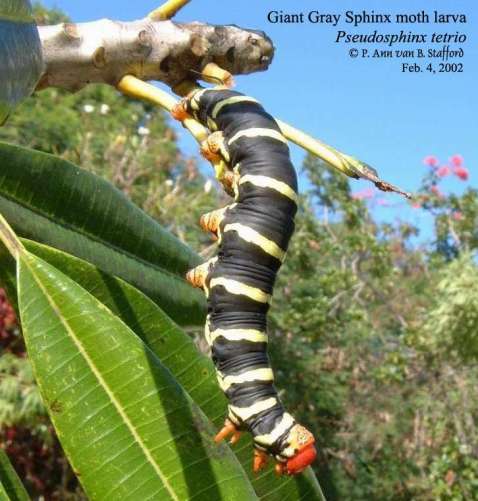 Giant Grey/Tetrio Sphinx Moth – Pseudosphinx tetrio, caterpillar feeding on Jasmine (Wild Frangipani, Graveyard Tree) – Plumeria obtusa. Photo: Ann Stafford, Grand Cayman, Feb. 4, 2002.
Giant Grey/Tetrio Sphinx Moth – Pseudosphinx tetrio, caterpillar feeding on Jasmine (Wild Frangipani, Graveyard Tree) – Plumeria obtusa. Photo: Ann Stafford, Grand Cayman, Feb. 4, 2002.
Erinnyis alope – Alope Sphinx Moth
 Alope Sphinx moth caterpillar – Erinnyis alope.
Alope Sphinx moth caterpillar – Erinnyis alope.
It was found by 9 year old Jonathan Bodden on White Fiddlewood tree (Citharexylum fruticosum), adjacent to its larval food plant, Papaya – Carica papaya.
It was on its way to pupate. George Town, Grand Cayman, Jan.4, 2015.
Below: Adult moth and pupa case from which it emerged in Jonathan’s house on Jan.23, 2015.
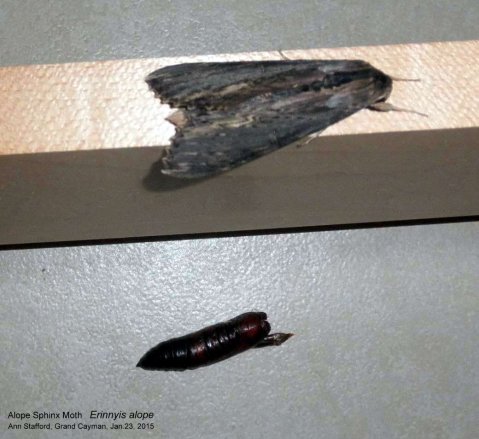
Erinnyis ello – Ello Sphinx Moth
Erinnyis oenotrus – Oenotrus Sphinx Moth
Erinnyis obscura – Obscure Sphinx Moth
Cautethia grotei – Grote’s Sphinx Moth
Grand Cayman (described as C. g. apira)
Cayman Brac (described as C. g. hilaris)
Aellopos tantalus – Tantalus Sphinx Moth, Hummingbird Sphinx Moth (attributed to Sesia tantalus zonata)

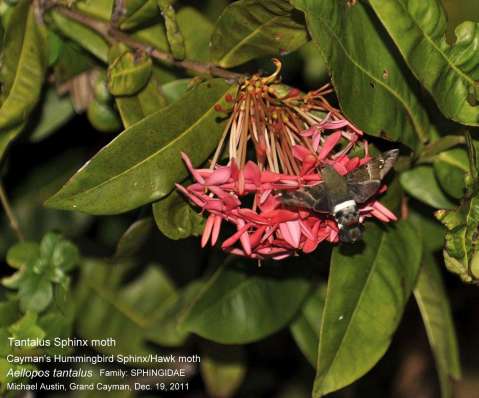 Tantalus Sphinx Moth, Hummingbird Sphinx/Hawk Moth – Aellopos tantalus, nectaring on Ixora flowers. Photo: Michael Austin, Grand Cayman, Dec. 19, 2011.
Tantalus Sphinx Moth, Hummingbird Sphinx/Hawk Moth – Aellopos tantalus, nectaring on Ixora flowers. Photo: Michael Austin, Grand Cayman, Dec. 19, 2011.
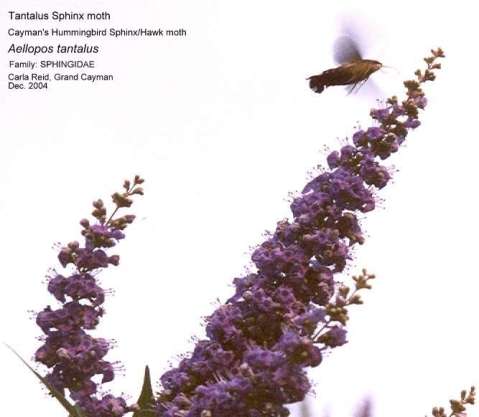 Tantalus Sphinx Moth, Hummingbird Sphinx/Hawk Moth – Aellopos tantalus, nectaring on Vitex, Butterfly Bush, Chaste Tree – Vitex agnus-cati flowers. Photo: Carla Reid, Grand Cayman, Dec. 2004.
Tantalus Sphinx Moth, Hummingbird Sphinx/Hawk Moth – Aellopos tantalus, nectaring on Vitex, Butterfly Bush, Chaste Tree – Vitex agnus-cati flowers. Photo: Carla Reid, Grand Cayman, Dec. 2004.
Eumorpha vitis – Vine Sphinx Moth
 Vine Sphinx Moth – Eumorpha vitis. Photo: Martin Keeley, Cayman Brac, May 29, 2014.
Vine Sphinx Moth – Eumorpha vitis. Photo: Martin Keeley, Cayman Brac, May 29, 2014.
Eumorpha fasciatus – Banded Sphinx moth
 Banded Sphinx moth – Eumorpha fasciatus. Photo: Peter Davey, Grand Cayman, Feb.10, 2018.
Banded Sphinx moth – Eumorpha fasciatus. Photo: Peter Davey, Grand Cayman, Feb.10, 2018.
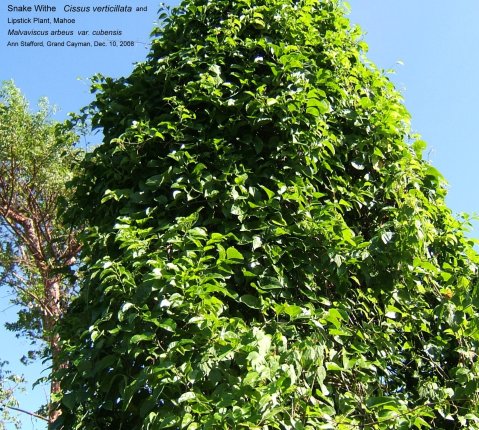 Snake Withe (Seasonvine) – Cissus verticillata (synonym C. sicyoides), above and below, likely larval food plant of Enyo lugubris, Eumorpha vitis, E. fasciatus & E. labruscae. subwoody vine that climbs on trees, rocks and fences.
Snake Withe (Seasonvine) – Cissus verticillata (synonym C. sicyoides), above and below, likely larval food plant of Enyo lugubris, Eumorpha vitis, E. fasciatus & E. labruscae. subwoody vine that climbs on trees, rocks and fences.
Cissus verticillata – more info
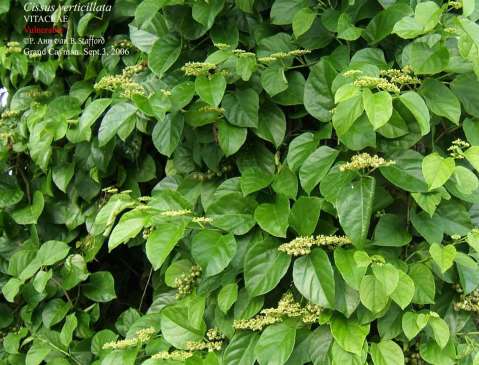
Eumorpha labruscae – Gaudy Sphinx Moth, Snake Caterpillar

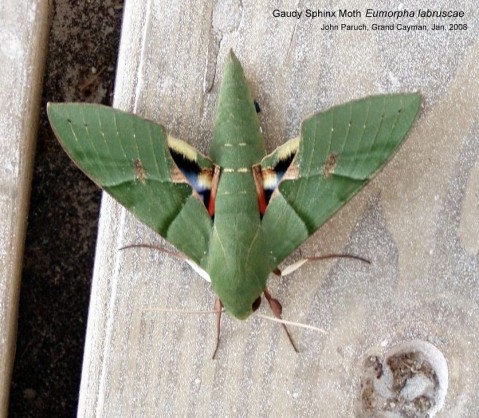 Gaudy Sphinx Moth, Snake Caterpillar – Eumorpha labruscae. Photo: John Paruch, Grand Cayman, Jan. 2008.
Gaudy Sphinx Moth, Snake Caterpillar – Eumorpha labruscae. Photo: John Paruch, Grand Cayman, Jan. 2008.
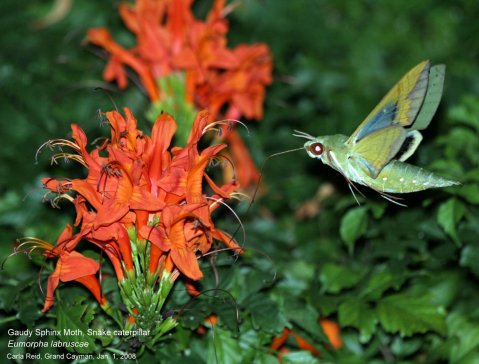 Gaudy Sphinx Moth, Snake Caterpillar – Eumorpha labruscae, nectaring on Cape Honeysuckle – Tecoma capensis. Photo: Carla Reid, Grand Cayman, Jan. 1, 2008.
Gaudy Sphinx Moth, Snake Caterpillar – Eumorpha labruscae, nectaring on Cape Honeysuckle – Tecoma capensis. Photo: Carla Reid, Grand Cayman, Jan. 1, 2008.
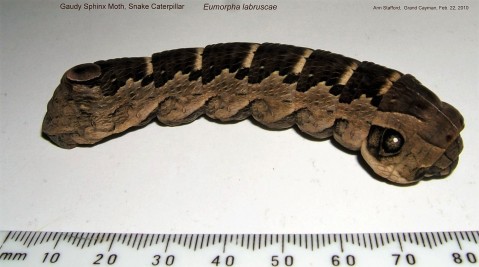
Snake Caterpillar, Gaudy Sphinx Moth – Eumorpha labruscae. Photo: Ann Stafford, Grand Cayman, Feb. 22, 2010.
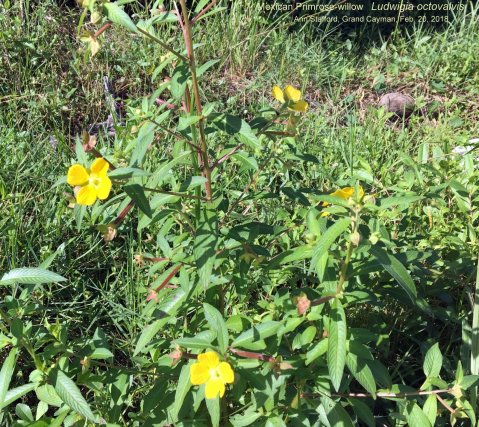 Mexican Primrose-willow – Ludwigia octovalvis, above and below, pantropical, a wildflower of low, moist ground. Fruit a capsule with numerous minute seeds. Proctor p.413. Possible larval food plant of Eumorpha vitis, E. fasciatus & E. labruscae and Hyles lineata. Grand Cayman, Feb. 20, 2018.
Mexican Primrose-willow – Ludwigia octovalvis, above and below, pantropical, a wildflower of low, moist ground. Fruit a capsule with numerous minute seeds. Proctor p.413. Possible larval food plant of Eumorpha vitis, E. fasciatus & E. labruscae and Hyles lineata. Grand Cayman, Feb. 20, 2018.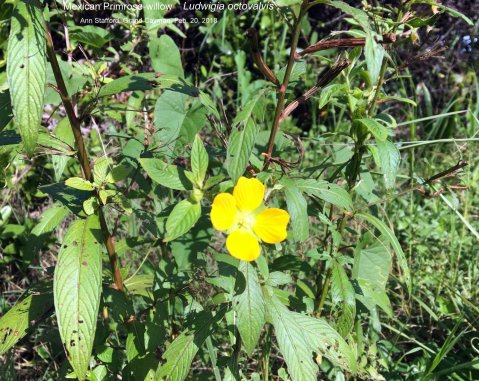
Xylophanes pluto – Pluto Sphinx Moth
Xylophanes tersa – Tersa Sphinx Moth
Hyles lineata – White-lined Sphinx Moth

Reference:
Jordan, K., 1940. Results of the Oxford University Biological Expedition to the Cayman Islands, 1938, Sphingidae (Lep.). Entomologist’s Monthly Magazine 76: 275–277.
INSECTS: FLIES (Order: Diptera)
Family: Culicidae – Mosquitoes
Family: Psychodidae, SubFamily: Phlebotominae, Sandflies (Luyzomyia) ?
ARACHNIDS:
Black Widow Spiders Order: Araneae, Family: Theridiidae – Comb-footed Spiders)
Latrodectus mactans – Southern Black Widow Spider – GC and LC
unidentified species – GC and CB (The Cayman Islands Natural History and Biogeography book p. 310, Chapter 16. Terrestrial invertebrates (other than insects) of the Cayman Islands by M. V. Hounsome).

Black Widow Spider, with egg sac, found by Carla Reid, Grand Cayman, May 2, 2003
BIRDS:
Avibase – Bird Checklists of the World – Cayman Islands:
Birds of the Cayman Islands Checklist
History of Ornithology in the Cayman Islands:
1880’s C. B. C. Cory (1857-1921), a wealthy amateur ornithologist and founder member of the American Ornithologist’s Union, was the first to study Cayman’s avifauna. He described 13 new species of landbirds. All but one, the Grand Cayman Thrush, were later reclassified as endemic subspecies (Bangs 1916).
1889 Charles J. Maynard first reported the two sulids as a single new species, later named as two:
Red-footed Booby on Little Cayman, and Brown Booby on Cayman Brac.
1892 C. B. C. Cory’s checklist of 55 species, 30 of them breeding.
Late 1910 – 1914 Thomas Mylius Savage English, naturalist, lived on Grand Cayman. He did not see the endemic Grand Cayman Thrush (Turdus ravidus) until his third year on the island.
1911 P. R. Lowe published a checklist of 75 species, 40 of them breeding.
1904 – 1938 Avian collectors visited from time to time. Their specimens were housed in various museums:
Chicago, New York, Washington, Boston (Harvard), London (Tring) and Baton Rouge (Louisiana).
1938 C. Bernard Lewis was the last person to record seeing the Grand Cayman Thrush, which became extinct.
Grand Cayman Thrush – Turdus ravidus
‘The beautiful Grand Cayman Thrush is extinct. The thrush was relatively common when first described in the 1880s, but was rare by the turn of the 19th century, and the last report came in 1938. It is unclear why this species went extinct, although habitat conversion, as well as hurricanes, have been blamed. This thrush was dark gray with a white belly, and dark, graduated tail with white tail corners; the bill and legs were bright red. The white-tipped tail, largely grayish plumage and red bare parts all suggest a close relationship with the Caribbean endemic Red-legged Thrush (Turdus plumbeus). Very little is known about this thrush as it was gone before much of the Caribbean was explored.’
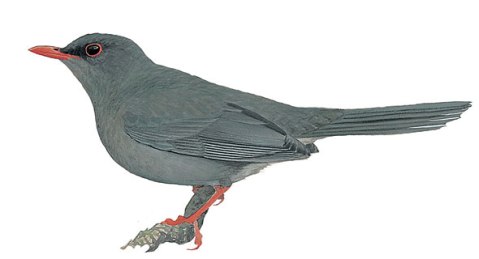
Thrushes, © Princeton University Press/ illustration by Ren Hathway

Grand Cayman Thrush on Cayman Islands 1/4 d (1/4 penny) = one farthing, stamp, June 5, 1969, when the Cayman Islands currency was British pounds, shillings and pence.
Grand Cayman Thrush – Turdus ravidus, GC endemic, is extinct. This was the only Cayman Islands endemic bird species, as opposed to subspecies.
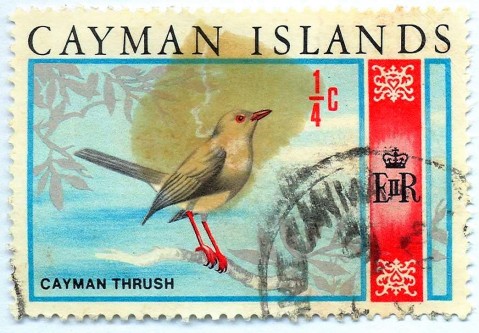
Grand Cayman Thrush on Cayman Islands 1/4 cent stamp, Sept. 8, 1970, after the Cayman Islands currency changed to the Cayman Islands Dollar from British pounds, shillings and pence.
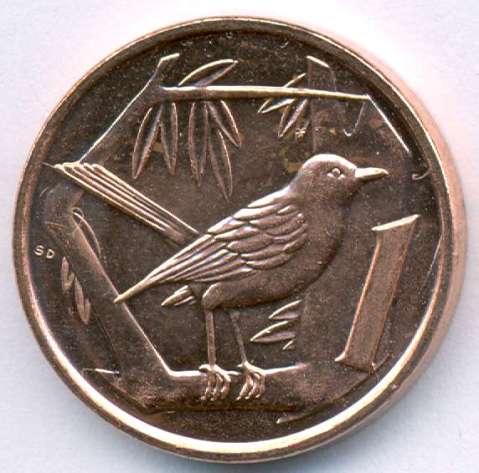
Grand Cayman Thrush on Cayman Islands 1 cent coin, currently in use.
MARINE:
W. Neil Paten (Magdalen College) was the Marine Biologist. (He was killed in World War II.)
 Map of North Sound (the Great Sound), Grand Cayman and the barrier reef.
Map of North Sound (the Great Sound), Grand Cayman and the barrier reef.
Vidal Cay (named after survey ship HMS Vidal), off Barkers, West Bay, is also known as Barkers Cay. It was the site of the original Stingray City, about 12 ft deep. Stingray City sandbar is the location of the current shallow, popular, Stingray City. Fisherman’s Rock can be seen as a pimple on the horizon from the southern area of North Sound, and is a useful landmark near the Main Channel through the reef.
Much of Gemmel Alexander’s work (the 19 year old Team Leader) was carried out in conjunction with Neil Paten, in North Sound, inside the reef, examining and collecting specimens from the spongy, Turtle Grass–covered bottom (Thalassia testudinum). They camped on the little schooner, the ‘Meritwell’, in North Sound for one week, and used a motor boat, operated by Benny Ross, and canoe for their biological observations and collections. Urban Myles was the cook.
Ford’s Lagoon is probably English Sound, (neither are marked on any maps), named after Thomas Mylius Savage English who live in Cayman for about 3 years (late 1910-1914). It is a very shallow lagoon, with a narrow entrance, off Little Sound, south of Rum Point.
 Jackson Point rock-pool, SW of George Town. Neil collected from the rock-pools on April 23 and 26, 1938.
Jackson Point rock-pool, SW of George Town. Neil collected from the rock-pools on April 23 and 26, 1938.
Neil had a lot of special requirements. He ran out of alcohol to preserve specimens, because they had done so much collecting, more than expected. They set up a still to make their own alcohol, in the garden of the house in George Town that was their headquarters.
The Cap Pilar , a 3-masted square rigged French Barquentine (Schooner Barque), owned and captained by Adrian Seligman (1909-2003), nearing the conclusion of its two year round the world voyage, visited Grand Cayman in June, on its way from Montego Bay, Jamaica (May), to New York (July). The Cap Pilar had a marine biologist on board, with equipment from the British Museum. W. Gemmel Alexander, Oxford Expedition Team Leader, cabled the British Museum to request the transfer of equipment from the Cap Pilar, in George Town harbour, to the Oxford Expedition. Permission was granted.
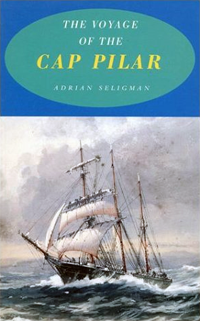
The purpose of the Cap Pilar’s two-year round the world voyage, begun in September 1936, captained by Adrian Seligman, then of Wimbledon, England, was partly adventure and partly to collect plants for the Royal Botanic Gardens, Kew.
The original botanist on the Cap Pilar was A. F. Roper, but when the ship reached South Africa on its outward journey, his place was taken by C.M. Maggs, then a Horticulturalist at the Kirstenbosch Botanical Garden, Cape Town, South Africa. The Cap Pilar visited Australia and after making collections on various Pacific Islands (including the Galapagos) and at Panama, made a final stop at Grand Cayman, where a few plants and seeds were collected.
The Cap Pilar set sail from Grand Cayman on June 23, 1938 and arrived in New York on July 12, 1938. They were upstaged by Howard Hughes, who had just flown around the world nonstop and was being given a ticker-tape reception up Broadway.
PLANTS
Wilfred Kings was invited to join the Oxford University Biological Expedition to the Cayman Islands by Gemmell Alexander on March 21, 1938 in the capacity of Botanist, as their Botanist was unable to join the Expedition at last moment.
Report on the Botanical Collections
from Grand Cayman, Cayman Brac and Little Cayman
Wilfred Kings Sept. 1938
Grand Cayman May 13 – May 17 and June 11 – Aug.10
Cayman Brac May 18 – May 28
Little Cayman May 28 – June 11
Kings saw Mr Alston at the British Museum (Natural History), explained the situation, and that he was not a Specialist in any capacity. They were satisfied that he should go merely as a Collector.
Mr Charles Elton and Dr Hobby in a interview at the Hope Department of Entomology, Oxford, were also willing for Kings to work in that capacity. Charles ELTON
Lawrence Sheriff School, Rugby, Governors granted Kings a leave of absence for the term, where he was the Geography Master. Kings eventually joined the party in Grand Cayman on May 13, 1938.
The Collection, as far as the Flowering Plants and Ferns were concerned, was almost entirely in duplicate.
FLORA of the CAYMAN ISLANDS by George R. PROCTOR, 2012 Extracts from p.19 and 21
‘The Oxford University Biological Expedition to the Cayman Islands, a party of five under the leadership of W.G. Alexander, carried out fieldwork from April 17 to August 27, 1938. The primary objects of attention were plants, insects, reptiles, and fishes, but nearly all animal taxa received some attention. The official botanist of this group was Wilfred W. KINGS, who joined the expedition about a month later than the others; he had been especially recruited from Lawrence Sheriff School, Rugby, because Oxford had no available botanist at that time. Before his arrival, some plant-collecting was done by C. Bernard LEWIS, whose interests were otherwise chiefly zoological. Kings gathered a large collection of material from all three islands; until recently, these excellent specimens constituted the major basis of our knowledge of the Cayman flora. The main set of the Kings collection is deposited at the British Museum (Natural History) in London, while duplicate material can be found in several other herbaria.
Lewis, then an Oxford student (a Rhodes Scholar from the United States), later became Director of the Institute of Jamaica in Kingston; he collected further Cayman plant specimens during the 1940s. His continued interest in the Cayman Islands has been a constant source of encouragement during the writing of this book.’
‘Collectors of Cayman Islands plants
Wilfred W. KINGS May-Aug. 1938. 645 specimens seen in Herbaria at British Museum, Gray Herbarium of Harvard University and Missouri Botanical Garden
Bernard LEWIS Apr. 1938, Dec. 1944, Mar. 1945, Dec. 1945. 45 specimens seen in Herbaria at British Museum and Institute of Jamaica.’
TROPICOS Missouri Botanical Garden, Collector W. Kings 1938
Grand Cayman localties visited:
George Town area – beach, bluff and pasture lands
East End – beach and bluff
West Bay – beach
South Sound – beach and bluff, mainly along ‘Leg and Knee Road’
Red Bay
East End – inland to the swampy Savannah Land
Little Sound
Governor’s Creek and Sound
Batabano – pasture land
Booby Creek
North Side – beach, bluff, Forest Glen, Cedar Cliff, Malportas Pond, Round Cay Pond, Savage English’s Cistern, Rum Point
Old Man Bay
North East Coast – from Old Man Bay to Roger Wreck
Frank Sound Bridge
George Town Barcadere
West Bay – North West Point, Mount Pleasant
Pedro Castle and Newlands
Cayman Brac localities visited:
Stake Bay
Earthquake Hole – Stake Bay Point, (east of the hospital and north of the caves, near to the coastline)
Cotton Tree Land, West End
West End
Across the Island from Stake Bay to the North Side with its abrupt Undercut Cliff and sandy coastal strip, with broken coral on the coastline.
Along the NE to Spot Bay and on the high bluff to the North East Point Lighthouse
Little Cayman localities visited, there were no roads on the Island:
South Town wide strip of coast land at the Western end – most collecting was done here.
Duck Hole
Track from South Town to SW of Bloody Bay
North coast to Jackson
‘Cross the Land Road’ to South Hole Sound
Extreme East End was visited by boat.
Information on place names and locations:
Round Cay, North Side, Grand Cayman
Where the ground is pure Coral Sand a plantation is made by collecting bush and coral rock from the shore, roughly in the proportion of 3:1 and burning this in a carefully constructed fire. On such a “Ground” at Round Cay, North Side, the owner grew six crops of maize in three years. No rotation or manuring is attempted and such ground is then left to grow bush for a few years and this is then burned for further planting. The constant burning of the bush also fragments the Limestone and improves the tilth. This method is commonly used in road-making.
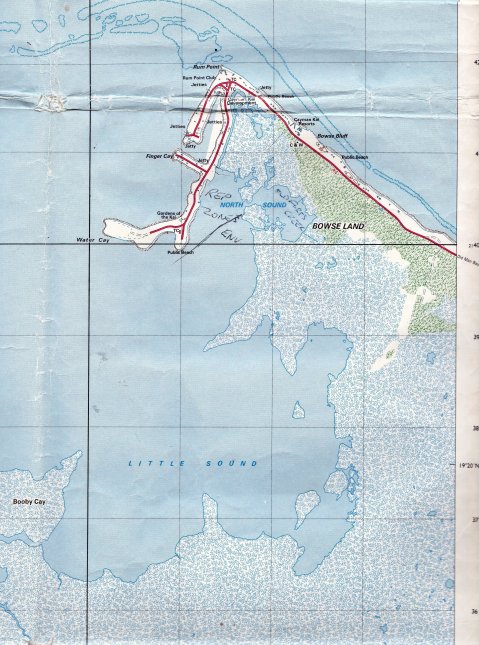
1988 Ordnance Survey map of the Rum Point, Cayman Kai, English Sound, Bowse Land area of North Side, Grand Cayman.
Savage English’s Cistern, Old Man English’s Cistern
Fresh Water Sponges – It was hoped to obtain specimens – for Mr. M. Burton of the British Museum (now the Natural History Museum, London) as I understand that none have been recorded from the Caymans. Only one possible specimen (and this may prove to be an alga) was found in SAVAGE ENGLISH’S CISTERN (the circular one) North Side. This cistern has not been used since about 1917 when the house was destroyed (by a hurricane).
Thomas Mylius Savage ENGLISH – naturalist, lived in Grand Cayman over a hundred years ago (late 1910 to 1914)
Link to List of plants by Collector – Kings, W. on Missouri Botanical Garden website, Tropicos.org: 1938 Oxford University Expedition to the Cayman Islands – Wilfred Kings flora specimens
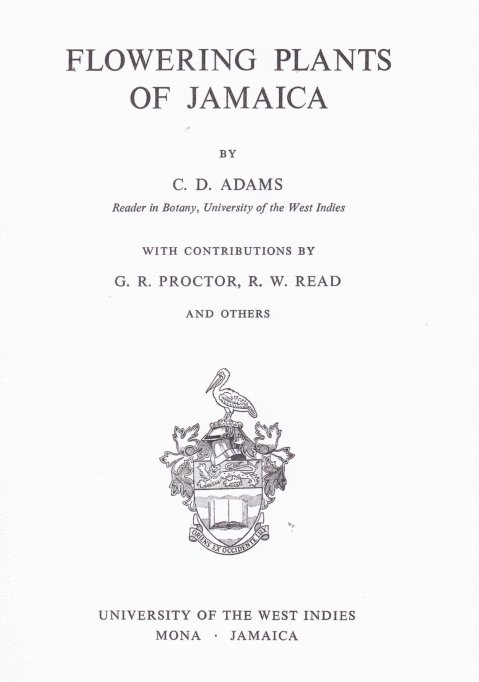 FLOWERING PLANTS of JAMAICA
FLOWERING PLANTS of JAMAICA
by C. Dennis Adams, 1972
Dennis Adams’ intermittent visits to the Natural History Museum (formerly the British Museum – BM), London, began in 1959 when it was suggested that he might get a useful preliminary overview of a West Indian flora by checking through a rather comprehensive collection of Cayman Island specimens (645) made there in 1938 by Wilfred Kings during the Oxford University Expedition. That was prior to Adams’ move from Ghana to Jamaica.
If a Cayman species was also found in Jamaica, Adams included it in the range in his book Flowering Plants of Jamaica 1972.
FLORA of the CAYMAN ISLANDS
by George R. Proctor, 2012
published by Royal Botanic Gardens, KEW
PLANTS INDEX
Cayman endemic*
Agalinis kingsii* – Kings Agalinis (Agalinis – False Foxglove)
Encyclia kingsii*
Heliotropium humifusum – Matlike Heliotrope
Phoradendron rubrum – Scorn-the-Ground
Salvia caymanensis* – Cayman Sage
Vanilla claviculata – Vanilla Orchid
PLANTS:
Kings 1938 – island and reference number: GC – Grand Cayman, LC – Little Cayman, CB – Cayman Brac
Plants named after Wilfred Kings:
Encyclia kingsii
Encylia kingsii Orchid (synonym Epidendrum kingsii), named after Wilfred Kings, biologist on the 1938 Oxford Expedition, June 7, Jackson, Little Cayman.
Encyclia kingsii
|
Encyclia kingsii (C.D. Adams) Nir, Lindleyana 9(3): 147. 1994.
|
The illustration (link) shows the shape of the lip, petal and sepal.
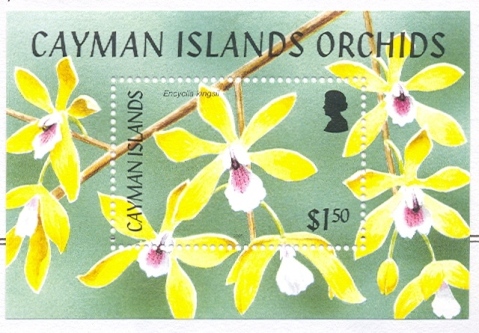
Encyclia kingsii Cayman Islands Orchid stamps issue 2005.
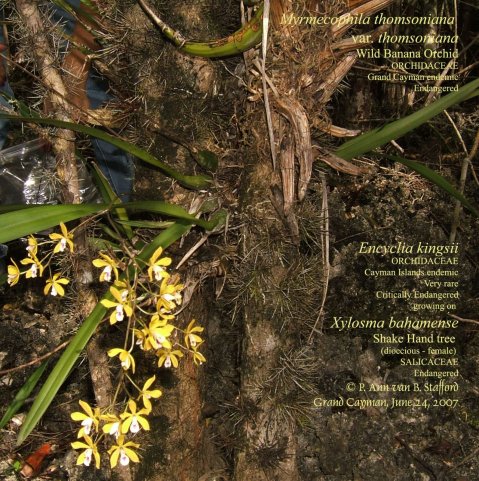
Encyclia kingsii and Banana Orchid (Myrmecophila thomsoniana var. thomsoniana) on Shake Hand tree (Xylosma bahamense). Photo: P. Ann van B. Stafford, East End, Grand Cayman, June 24, 2007. Flora of the Cayman Islands by George R. Proctor, 2012, p.201, 206 & 319. Grand Cayman, June 24, 2007.
Grand Cayman, June 24, 2007.
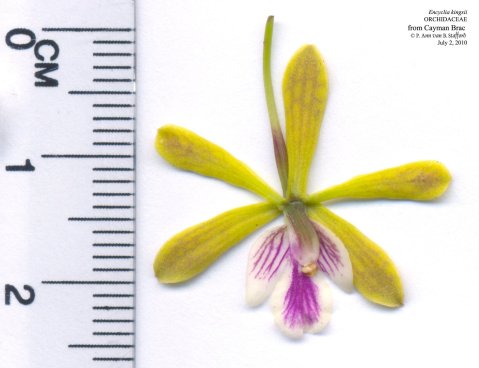 Encyclia kingsii (= Epidendrum kingsii), ORCHIDACEAE, from Cayman Brac, in a private collection in Grand Cayman. P. Ann van B. Stafford, July 2, 2010.
Encyclia kingsii (= Epidendrum kingsii), ORCHIDACEAE, from Cayman Brac, in a private collection in Grand Cayman. P. Ann van B. Stafford, July 2, 2010.
Agalinis kingsii* Proctor, Sloanea 1: 3 (1977)
King’s Agalinis (Agalinis – False Foxglove) Agalinis kingsii

A hemiparasitic slender ANNUAL herb with pink flowers, Critically Endangered Grand Cayman endemic, (Family was SCROPHULARIACEAE, is now OROBANCHACEAE) was collected by Kings (Kings GC 257) “in mangrove swamps on the drier land” at Forest Glen, North Side. The species has since been found east of Duck Pond Bight and south of the Salina Reserve (Proctor, Aug. 8, 1992).
Ref. Flora of the Cayman Islands by George R. Proctor, p. 601, Fig. 224, Plate 58.
Agalinis kingsii – IUCN Red List
In the Salina Reserve sedge wetlands, this species appears to benefit from fire. This occasionally spreads from neighbouring agricultural land and burns back stands of Cladium jamaicense sedge during the dry season. In the Central Mangrove Wetland the species colonizes exposed peat in trail clearings through Conocarpus erectus shrubland, suggesting that populations might expand widely in the Central Mangrove after widespread tree fall resulting from major hurricanes.

Agalinis kingsii, showing habitat, with Cutting Grass, Saw Grass – Cladium jamaicanse (Sedge) and Buttonwood – Conocarpus erectus. Photo: Maribeth Latvis, Salina Reserve, Grand Cayman, 2011.
This species is reported to be hemi-parasitic, tapping into root connections to other plants. An unknown species of ant colonizes the raised peat mounds where the species grows. These ants may be involved in pollination and/or dispersal of its seeds.
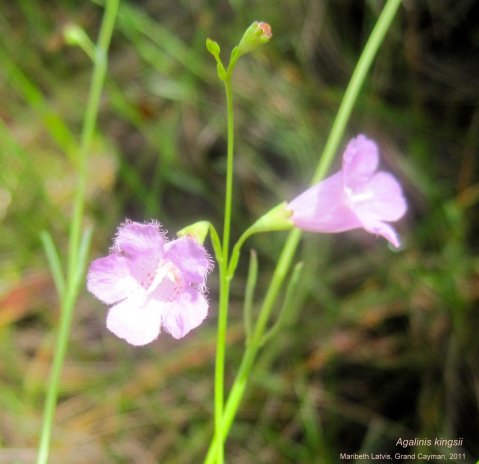
Agalinis kingsii, photo: Maribeth Latvis, Salina Reserve, Grand Cayman, 2011.
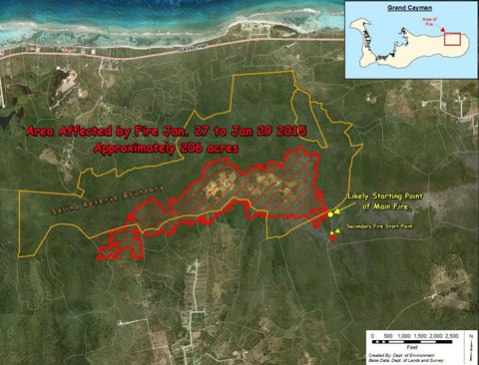
Salina Reserve, where Agalinis kingsii grows, affected by fire.
Fire burns Salina Reserve, Jan. 2015
The reserve, which is owned and maintained by the Cayman Islands National Trust and is home to hundreds of the protected indigenous Blue Iguana (Cyclura lewisi), is described on its website as totaling 646 acres “comprising sedge and buttonwood swamps, dry shrubland and forest in an intricate mosaic.”
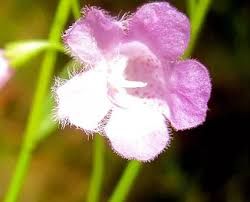
Expeditions 2011: Grand Cayman Island Agalinis kingsii, Maribeth Latvis
Maribeth Latvis – Plant Systematics and Evolution
Plants recorded by Wilfred Kings in 1938 (A – Z scientific name):
Heliotropium humifusum – Matlike Heliotrope Kings GC 59, LC 48, LC 78
Phoradendron quadrangulare – Scorn-the-Ground.
Kings: GC 14, GC 150, GC 365, GC 388 ? CB 91.
Small shrub, parasitic on
Cabbage tree – Guapira discolor on Grand Cayman
Rosemary – Croton linearis on Little Cayman
Bull Hoof – Bauhinia divaricata on Cayman Brac.
 Scorn-the-Ground – Phoradendron quadrangulare. Photo: Ann Stafford, Grand Cayman, March 19, 2017.
Scorn-the-Ground – Phoradendron quadrangulare. Photo: Ann Stafford, Grand Cayman, March 19, 2017.
Phoradendron rubrum – Scorn-the-Ground.
Kings: GC 165, GC 388 ? LC 36, LC 43. Lewis: GC 14
Small shrub, parasitic on Mahogany – Swietenia mahogoni and Cabbage tree – Guapira discolor. Cayman Islands Bahamas and Cuba
The berries of Scorn-the-Ground plants are dispersed by birds.
Salvia caymanensis* – Cayman Sage
Kings: GC 422, Proctor p.590.
Vanilla claviculata – Vanilla Orchid
Kings GC 412 Proctor p.190.
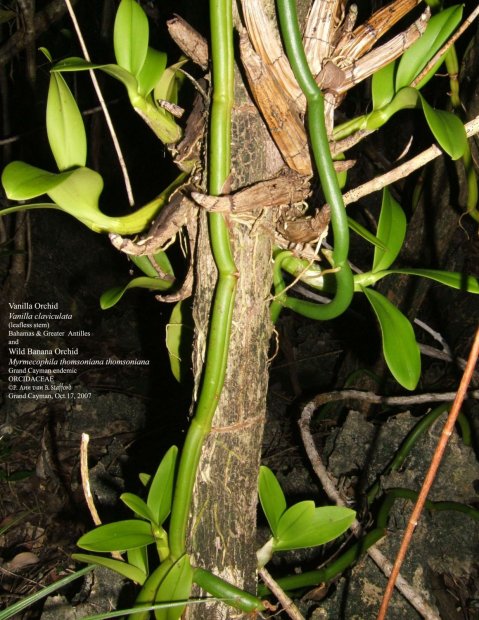 Vanilla Orchid – Vanilla claviculata, leafless stem, and Grand Cayman Banana Orchid – Myrmecophila thomsoniana var. thomsoniana*, Grand Cayman, Oct. 17, 2007.
Vanilla Orchid – Vanilla claviculata, leafless stem, and Grand Cayman Banana Orchid – Myrmecophila thomsoniana var. thomsoniana*, Grand Cayman, Oct. 17, 2007.
Fresh water sponges?
Thomas Mylius Savage English’s Cistern (the circular one). Photo: C. Bernard Lewis, North Side, Grand Cayman, 1938.
Wilfred Kings hoped to obtain specimens of Fresh Water Sponges for Mr Burton of the British Museum, as none had been recorded from the Cayman Islands. The only possible specimen, which might have proved to be an alga, was found in this cistern, which had not been used since 1917 when the house was destroyed by a hurricane.
Farewell
In 1930 Leila Ross-Shier (nee McTaggart) composed a song she called “Beloved Isle Cayman” and for many years it was regarded as the unofficial national song. It was not until 1993 when it became the official national song when the Cayman Islands Coat of Arms, Flag and National Song Law were passed. She was the mother of Benny Ross, boat owner and driver.
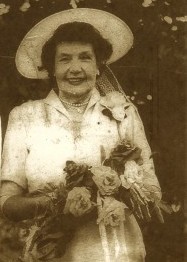
She wrote a poem of farewell to the Oxford team in C. Bernard Lewis’s copy of the book Life and Adventures in the West Indies, by Vaquero, originally published in 1914, which it in the Cayman Islands National Archive.
Oxford University Cayman Islands Biological Expedition
by Leila E. Ross
August 18, 1938
It seems so unworthy to tell your worth,
For you are the very salt of the earth,
Messrs. Alexander, Thompson, Neil, Lewis and Kings,
We wish you the best of all good things.
You have shared our hardships, and our joys,
Grown friendly with our girls and boys;
You have killed mosquitoes, butterflies caught
And wonderful things with your hands have wrought.
We wish you “Godspeed” as home you go
Starting out on the good ship “CIMBOCO”;
May you find your loved ones happy and well,
Good news of our isle be able to tell.
But we hope that sometime soon you’ll come
Again, to visit our island home,
For we have grown so used to you, you know,
We shall very much miss you, when you go.
Aug. 10 to 15, third Storm, 2nd. Hurricane of 1938 passes close to Grand Cayman.
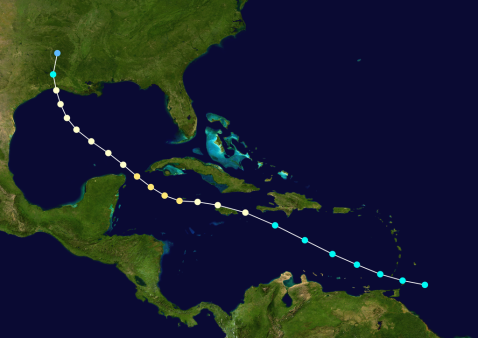
It strengthened into a hurricane as it passed just north of Jamaica and became a Category 2 storm while near Grand Cayman.
Return to the UK
Types and paratypes are held in South Kensington Natural History Museum, London, the Hope Department of Entomology, Oxford, London Zoo and American Zoos.
Aug. 31, 1938. Quote from The Telegraph, 31.8.38 under the heading GREEN TURTLES AND IGUANAS ‘Animals and reptiles rarely, if ever, seen in Europe, were landed in Liverpool today on the return, after a six month absence, of members of the Oxford University expedition to the Cayman Islands in the West Indies…….some of the specimens will shortly be seen at the London Zoo, which is to have the choice of the collection………’
The collection included 19 iguanas or spine lizards up to four feet in length, two green turtles, four hawksbill turtles, 16 land turtles, several lizards and land crabs, 27 black snakes and nine wood snakes as well as spiders, scorpions and centipedes.
LINKS:
1938 Oxford Expedition to the Cayman Islands pictures
1938 Oxford University Expedition – Gerald Thompson’s account
Butterflies of the Cayman Islands – Book
Butterflies of the Cayman Islands – List
Cayman Islands National Archive
Flora of the Cayman Islands by George R. Proctor 2012 – Book
Insect Fauna of Little Cayman – R.R. Askew 1975
Little Cayman is seldom mentioned in entomological literature. The 1938 Oxford University Biological Expedition spent thirteen days on the island and reports on the resulting collection deal with Odonata (Fraser, 1943), water-bugs (Hungerford, 1940), Nemoptera (Banks, 1941), cicadas (Davis, 1939), Carabidae (Darlington, 1947), Cerambycidae (Fisher, 1941, 1948), butterflies (Carpenter and Lewis, 1943) and Sphingidae (Jordan, 1940). During the 1975 expedition, insects of all orders were studied, over a period of about five weeks, and many additions will eventually be made to the island’s species list. At present, however, identification of the insects collected has, with the exception of the butterflies which have been considered separately, proceeded in the majority of cases as far as the family level. Application of the family names for the most part follows Borror and DeLong (1966). In this paper the general characteristics of the insect fauna are described.
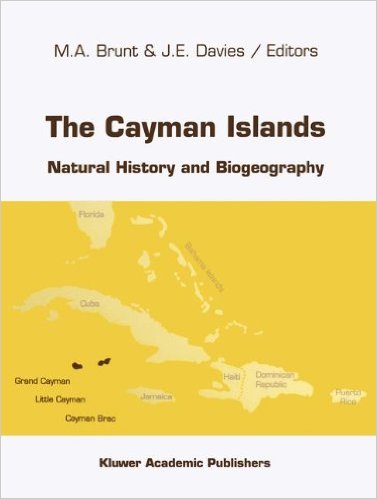
The Cayman Islands Natural History and Biogeography
M.A. Brunt & J.E. Davies / Editors, 1994
Selected References:
Adams, C. Dennis 1972 Flowering Plants of Jamaica (Reader in Botany at the University of the West Indies, Mona, Jamaica.
Bradley, P.E and Rey-Millet, Y-J. 2013 Birds of the Cayman Islands
Cayman Islands National Archive
Cerambycidae of the World
https://apps2.cdfa.ca.gov/publicApps/plant/bycidDB/wdefault.asp
Kings, Wilfred September 1938 Report on the Botanical Collections from Grand Cayman, Cayman Brac and Little Cayman
Lewis, C. Bernard, Photographic Collection 1938. Cayman Islands National Archive Accession No. 414 B.
Cayman Islands 2011 Biodiversity Snapshot
Find Cayman’s Wild Side!
Win a luxury wildlife holiday in the Cayman Islands
The Cayman Islands are delighted to announce the launch of the new UK Wildlife Explorer’s Guide to the Cayman Islands.
In celebration, photographer Will Burrard-Lucas, Wildlife Worldwide and responsibletravel.com have partnered to bring you the opportunity to experience Cayman wildlife yourself! Your chance to win a holiday for two people including accommodation, flights from London and various wildlife activities is just a few clicks away….
“The Cayman Islands teem with wildlife. Wherever you are, you don’t have to travel far to escape the areas of human habitation and you will soon find yourself surrounded by a menagerie of birds, butterflies, lizards and other creatures. Most of the animals have no fear of humans which makes for some wonderful, intimate encounters. And that is just the wildlife on land..the underwater world is also breathtakingly beautiful.” – Will Burrard-Lucas
(If entering from outside of the UK please be aware that you will be required to fund your travel to London.)



